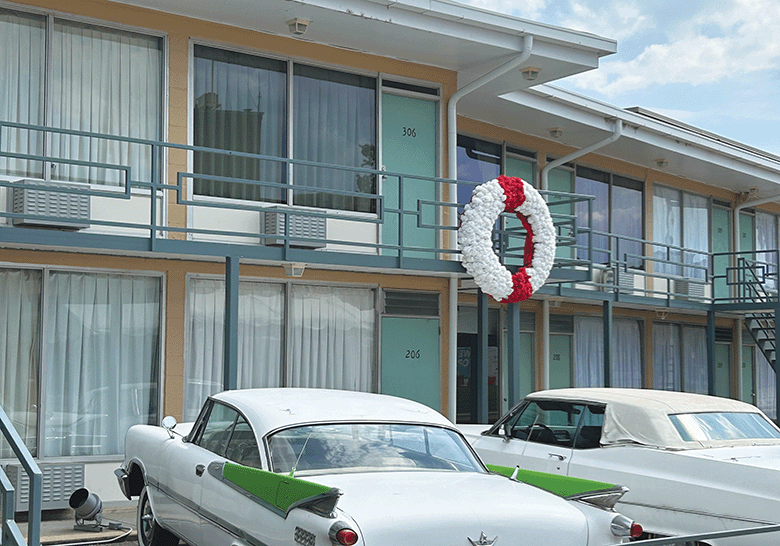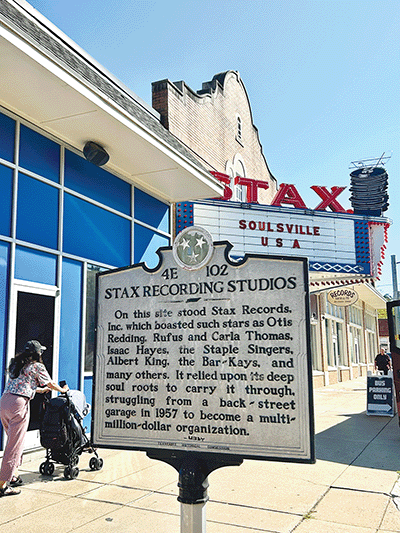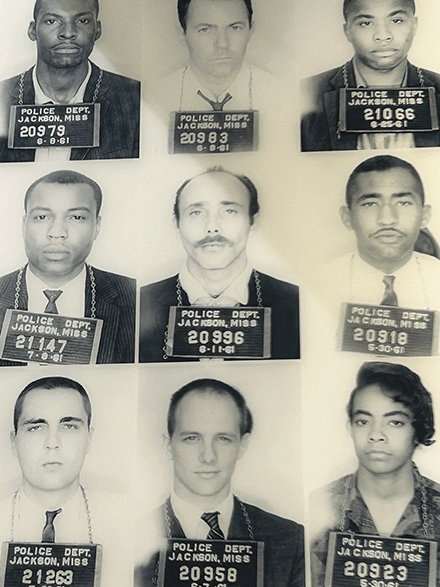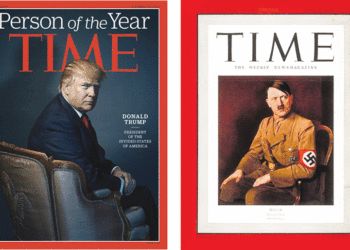
“Damn the law. Down here, we make our own law.”
— Eugene “Bull” Connor, commissioner of public safety for the city of Birmingham, Alabama, 1958
On Sept. 19, we flew from MSP to Memphis, Tennessee. This was not the entire family, as I noted about our expedition to the Black Hills in July (AJW, August 2024). Rather, our traveling party included my wife, Maj-Britt; eldest son, Jonas; daughter-in-law Shira Burton; and adorable grandchildren Ira and Naomi.
Maj-Britt and I were drafted as babysitters; Jonas and Shira were attending the wedding of some friends. But we were together for much of an extended weekend in Memphis.
Editorial
It wasn’t until arriving in Memphis that I got the lay of the land. The largest city on the Mississippi River is just north of the state of Mississippi. If you cross the bridge west of downtown Memphis, you’re in Arkansas. I had never been in this part of the country.
Memphis, a city of 663,000 residents, is known for numerous attractions, such as Graceland, which was the home of Elvis Presley. It’s a historical center of gospel, blues and soul music. We visited famous Beale Street, a three-block stretch of music venues, including B.B. King’s Blues Club. One of our first visits after arriving was to the Stax Museum of American Soul Music.
The Stax label, which started in the late 1950s, became renowned for its roster of artists that included Otis Redding, Sam and Dave, Carla Thomas, Wilson Pickett, Rufus Thomas, The Staple Singers, Booker T and the MGs, et al.

A short introductory film orients visitors to the storied record label, which originally was called Satellite Records. Banker and fiddler Jim Stewart founded the label. When money was tight, Stewart asked his sister, Estelle Axton, for a loan, and Stax — which incorporated the first two letters of their surnames — was born. In 1960, a movie house called the Capitol Theater became the label’s headquarters, and the building houses the current museum, which is adjacent to the Stax Music Academy.
In the Jim Crow South of yesteryear, where racial segregation was the law, Stax was an integrated scene. The owners were white, and the musicians were white and Black. Eventually, the local racists objected to the situation of racial harmony in pursuit of sweet soul music that prevailed at Stax.
As the Stax Museum website notes, “When citizens rioted in the streets after King’s murder, Stax’s building was left untouched, but the studio’s atmosphere as a creative respite with no regards for race was forever altered.” An exhibit of the studio’s master tapes mentions that Jim Stewart loaded tapes into his car and took them to a secure location as the city burned in 1968.
The United States is a profoundly racist country. Much of my journalism over the past 50 years has focused on the government’s depredations against Native people; I still write a monthly column titled “Political Matters” for The Circle, the Native newspaper in Minneapolis. I also participated in Civil Rights and anti-Vietnam War protests going back to my teenage years.
I occasionally pause to wonder how, in 2020, following the police murder of George Floyd in our Powderhorn Park neighborhood, Minneapolis became the epicenter of a global racial justice movement. The accounting for past crimes is ongoing, and perhaps, someday, there will be a national reconciliation process, like the initiative taken in South Africa after the fall of the apartheid regime. We’re not out of the woods yet.
On the theme of our tortured history of race relations, I set off on my own to visit the National Civil Rights Museum at the Lorraine Motel. The museum incorporates the motel where, on April 4, 1968, the Rev. Martin Luther King, Jr., who had traveled to Memphis to support striking sanitation workers, was cut down by an assassin’s bullet as he stood with some associates on a balcony.
This exemplary museum begins with exhibits about the trans-Atlantic Slave Trade and moves through various eras of Black struggles for freedom. The Civil Rights Movement is explicated in great detail, and I learned a lot while reading and moving through the exhibits.
For example, many Americans know the name of Rosa Parks, who refused to give up her seat on a Montgomery, Alabama, bus and sparked the Montgomery Bus Boycott, a mass protest that lasted for 13 months, in 1956, and led to the Supreme Court affirming a lower court decision ruling that bus segregation was unconstitutional.
However, a museum exhibit about these events informs visitors that in 1955, a 15-year-old named Claudette Colvin was arrested for refusing an order to give up her seat on a Montgomery bus. The Martin Luther King, Jr. Research and Education Institute at Stanford University notes on its website that seven months after Colvin’s action, “18-year-old Mary Louise Smith was arrested for refusing to yield her seat to a white passenger. Neither arrest, however, mobilized Montgomery’s black community like that of Rosa Parks later that year.”
The museum’s detailed history of the Civil Rights struggle does not shy away from contentions within the movement. MLK’s nonviolent resistance to systemic racism was challenged at different junctures. I watched one video of a TV panel discussion that featured Malcolm X and several civil rights activists. Malcolm X, a member of the Nation of Islam, suggested that conventional protests might bear fruit in “100 years or 200 years.” In addition to continuous surveillance by the FBI, King’s views were gainsaid by others in the movement.
An exhibit in the museum explains the rise of Black Power and the emergence of other movements for Latino, gay and women’s liberation in the late 1960s, especially in the pivotal year of 1968. A denim jacket with a large American Indian Movement patch on the back can be seen in one display case, with interpretation of AIM’s organizing on behalf of Indian treaty rights and resurgent Native identity. AIM started as a street patrol monitoring the police on Franklin Avenue, the urban rez in Minneapolis.
And I saw photos of two people I knew: Marv Davidov, of Minneapolis, and Charles McDew.

I worked with Davidov, beginning in the early 1980s, on the Honeywell Project, which organized mass civil disobedience against Honeywell’s weapons production. Davidov was a co-founder of the Honeywell Project during the Vietnam War era, when the issue was the corporation’s manufacture of cluster bombs, which were deployed throughout Southeast Asia. Long after the war’s end, unexploded bomblets continued to detonate and maim and kill civilians. I was arrested a few times at Honeywell headquarters in South Minneapolis.
Marv Davidov was one of the Freedom Riders that set off to desegregate public facilities across the South. He was arrested in Jackson, Mississippi, and imprisoned in the state’s notorious Parchman Farm prison. Two other local Jews, Bob Baum and Zev Aelony, also risked their lives in the cause of Black civil rights.
Among the extensive exhibits on student-led lunch counter sit-ins, in 1960, and the Freedom Rides, in 1961, there are displays on the founding of the Student Nonviolent Coordinating Committee (SNCC). Among the student founders of SNCC was Charles “Chuck” McDew, who was a student at South Carolina State University, in Orangeburg, South Carolina. I met McDew many years ago through a mutual friend, Dick Bancroft, a photographer who I worked with on stories about American Indian issues. McDew, who died in 2018, was Jewish and lived in West St. Paul toward the end of his life. According to a lengthy news obituary in the New York Times, McDew had retired from Metropolitan State University, where he taught African-American history.
We enjoyed good food in Memphis — fried catfish, barbecue and Vietnamese and Mexican cuisine. We played with the grandkids in the parks, including Tom Lee Park, a 30-acre recreational area stretching along one mile of riverbank near downtown.
I have to say that the National Civil Rights Museum provided the most impact and food for thought. With national elections coming in a few weeks, I have thought about the struggle for Black freedom and the right to vote, which is a sacred legacy for all Americans. Freedom Summer in 1964, a campaign to register Black voters in the South, was met by violent repression, which included the murder of three civil rights workers: James Chaney, a Black man; and Andrew Goodman and Michael “Mickey” Schwerner, two young Jews from the North. They were among the countless activists, some of their names little known, who bled and died in the course of the Black freedom struggle.
A tour of the museum ends in a small corridor that cuts into the old Lorraine Motel. Behind plate glass are two motel rooms where, in 1968, the civil rights activists stayed. On the right is room 306, where Martin Luther King Jr. spent his last night on this plane of existence. The trays of food, coffee cups and newspapers are replicated to show how the room looked before he stepped out on the balcony and entered eternity.
Mordecai Specktor / editor [at] ajwnews [dot] com
(American Jewish World, October 2024)




















